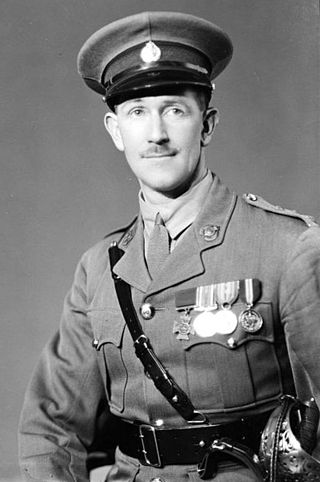
Brigadier Leslie Wilton Andrew, was a senior officer in the New Zealand Military Forces and a recipient of the Victoria Cross, the highest award of the British Commonwealth for gallantry "in the face of the enemy". He received the decoration for his actions during the Battle of Passchendaele in 1917.

The 28th (Māori) Battalion, more commonly known as the Māori Battalion, was an infantry battalion of the New Zealand Army that served during the Second World War.
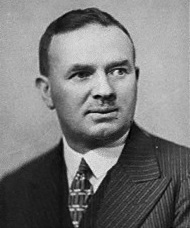
Brigadier James Hargest, was an officer of the New Zealand Military Forces, serving in both the First and Second World Wars. He was a Member of New Zealand's Parliament from 1931 to 1944, representing firstly the Invercargill and then the Awarua electorates.

The 27th Machine-Gun Battalion was a unit of the 2nd New Zealand Division during the Second World War. It served in the Greek Campaign, Western Desert Campaign, Tunisian Campaign, Italian Campaign and after the war took part in the Occupation of Japan. It was one of two New Zealand formations that served overseas longer than any other unit in the New Zealand Expeditionary Force. The battalion was also one of the New Zealand units that supplied men for the Long Range Desert Group.
The 23rd Battalion, also known as the Canterbury-Otago Battalion, was an infantry battalion of the New Zealand Military Forces during the Second World War. Formed in November 1939 as part of the 5th Brigade, 2nd Division of the 2nd New Zealand Expeditionary Force. After undertaking training at Burnham Camp the battalion sailed from New Zealand on 1 May 1940. The battalion saw action in Greece, Crete, North Africa, and Italy.
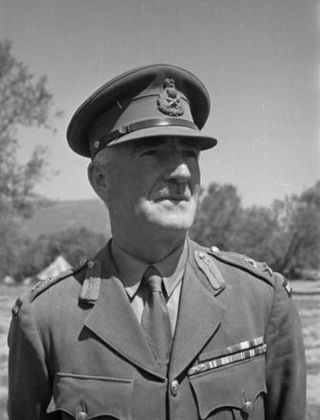
Lieutenant General Sir Edward Puttick, was an officer who served with the New Zealand Military Forces during the First and Second World Wars. The first New Zealand-born soldier to reach the rank of lieutenant general, he was Chief of the General Staff of the New Zealand Military Forces from 1941 to 1945.

Colonel Neil Lloyd Macky MC was a New Zealand lawyer and military leader.
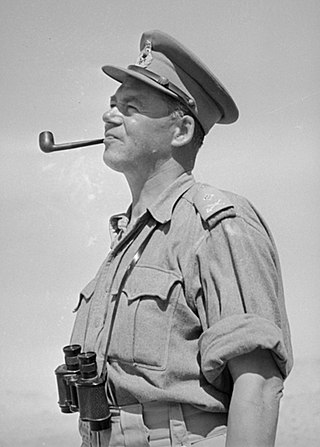
Major-General Lindsay Merritt Inglis, was a New Zealand military officer, lawyer and magistrate. Born in Mosgiel, he volunteered for service in the New Zealand Expeditionary Force during World War I. Inglis served on the Western Front and was awarded the Military Cross for his actions during the Battle of Flers-Courcelette. He ended the war as a company commander and returned to New Zealand in 1919.

Brigadier Frederick Melrose Horowhenua Hanson was a New Zealand soldier, engineer, military leader and public servant.

The 20th Battalion was a formation of the New Zealand Military Forces which served, initially as an infantry battalion and then as an armoured regiment, during the Second World War as part of the 2nd New Zealand Division.
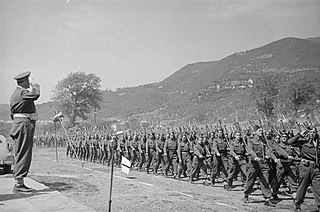
The 5th Infantry Brigade was an infantry brigade formation of the New Zealand Military Forces, active during World War II as part of the 2nd New Zealand Division. It saw service during the Battle of Greece, the Battle of Crete, the North African Campaign and the Italian Campaign before being disbanded in late 1945.

The 6th Infantry Brigade was an infantry brigade of the New Zealand Military Forces, active during World War II as part of the 2nd New Zealand Division. It saw service during the North African Campaign and the Italian Campaign before being disbanded in late 1945.

The 19th Battalion was a formation of the New Zealand Military Forces which served, initially as an infantry battalion and then as an armoured regiment, during the Second World War as part of the 2nd New Zealand Division.

The 18th Battalion was a formation of the New Zealand Military Forces which served, initially as an infantry battalion and then as an armoured regiment, during the Second World War as part of the 2nd New Zealand Division.

The 24th Auckland Battalion was an infantry battalion of the New Zealand Army during the Second World War. The 24th Battalion was formed on 1 February 1940 and embarked for Egypt on 28 October 1940. It was part of the 6th Infantry Brigade, part of the 2nd New Zealand Division. The battalion fought in Greece, North Africa and Italy. After the conclusion of hostilities, the battalion was disbanded in December 1945.

The 25th Battalion was an infantry battalion of the New Zealand Military Forces, which served during the Second World War as part of the 6th Infantry Brigade, 2nd New Zealand Division.
The 26th Battalion was an infantry battalion of the New Zealand Military Forces, which served during the Second World War as part of the New Zealand 2nd Division. Raised in May 1940, it fought in the Battle of Greece, the North African Campaign and the Italian Campaign. It finished the war in Trieste and was disbanded in December 1945.

Brigadier George Herbert Clifton, was a senior officer in the New Zealand Military Forces and a three-time recipient of the Distinguished Service Order.

The German invasion of Greece on 6 April 1941, had already been anticipated by the Allied forces. So a defense line was created across the mountain passes near Mount Olympus consisting of British, Australian and New Zealand troops which would prevend the German forces from capturing Thessaly and thereby denying them the opportunity to advance into mainland Greece. However, the speed of the German invasion force had made sure that the endurance of the defending troops and the strength of their defences were very quickly going to be put to the test.
The 10th Infantry Brigade was a brigade of the New Zealand Military Forces formed on two separate occasions during the Second World War. The brigade was first formed as part of the 2nd New Zealand Division, just prior to the Battle of Crete. It consisted of a variety of New Zealand artillery and support units operating as Infantry, as well as two Greek Infantry regiments. The 10th Brigade was absorbed by 4th Brigade part way through the battle. The 10th Brigade was formed for the second time in New Zealand as a territorial force formation in November 1941 and became part of the 5th Division. By 1944 the threat of Japanese invasion was perceived to be minimal and the 10th Brigade was disbanded.
















